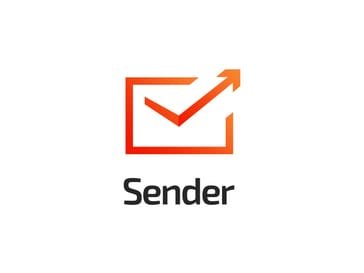Choosing the right email marketing tool is like picking the perfect companion for a long journey. It needs to be reliable, adaptable, and capable of meeting your needs every step of the way. In the bustling world of email marketing, two names often come up: Sender and Mailshake. Each offers unique features and capabilities, but which one will be the best partner for your marketing adventures? Let’s embark on a journey to uncover the strengths and differences between Sender and Mailshake, starting with one of the most critical aspects: ease of use.
| Sender | Mailshake |
|---|---|
 |  |
| G2 Score – 4.4 out of 5 stars | G2 Score – 4.7 out of 5 stars |
| TrustRadius Score – 5.2 out of 10 | TrustRadius Score – 8.6 out of 10 |
Ease of Use: Your First Step to Email Marketing Success
Sender: Simplifying Your Marketing Journey
Sender is designed with simplicity at its core, making it an ideal choice for small businesses and marketers who are new to the email marketing scene. Imagine walking into a room where everything is exactly where you expect it to be; that’s the feeling you get with Sender. Its intuitive interface ensures that from the moment you sign up, you’re guided through each step with clarity and ease.
Creating and launching campaigns with Sender feels like a breeze. With its drag-and-drop email editor, you can easily design stunning emails without any prior design knowledge. This user-friendly approach extends to its automation features, allowing you to set up effective email sequences without getting tangled in complexity. For those who value straightforwardness and efficiency, Sender is a breath of fresh air.
Mailshake: Mastering the Art of Email Outreach
Mailshake takes a slightly different approach, focusing primarily on cold email outreach and sales engagement. While it may not offer the traditional newsletter-style email marketing features of Sender, it excels in its domain. Mailshake is for the marketers and sales professionals who want to craft personalized outreach campaigns that resonate with their recipients.
The platform offers a variety of templates and customization options to fine-tune your messages for maximum impact. However, the real power of Mailshake lies in its advanced features designed to enhance your outreach efforts, such as automated follow-ups, lead catchers, and integration with CRM systems. For users who are comfortable with a steeper learning curve in exchange for powerful sales-focused tools, Mailshake is an enticing option.
Navigating the User Experience
When deciding between Sender and Mailshake based on ease of use, consider your primary email marketing goals. If you’re looking for a tool that simplifies the email marketing process and helps you quickly create beautiful campaigns, Sender’s user-friendly interface and straightforward functionality are unbeatable. It’s perfect for businesses that want to engage their audience with minimal fuss.
On the other hand, if your focus is on cold email outreach and you’re willing to dive into a tool that offers specialized features for sales engagement, Mailshake’s robust platform is worth exploring. Although it might require a bit more time to master, the potential rewards for your sales efforts can be substantial.
In the end, the choice between Sender and Mailshake should align with your specific needs, whether you prioritize ease of use and simplicity or specialized features for sales outreach.
Pricing and Plans: Balancing Cost with Value
| Sender | Free Plan: Up to 2,500 subscribers and 15,000 emails per month. Includes basic features like newsletters and subscription forms. Standard Plan: Starting at $11/month for up to 5,000 subscribers and 60,000 emails. Includes advanced features like autoresponders and transactional emails. Professional Plan: Custom pricing based on higher volumes of subscribers and emails, including additional features like dedicated IP and webhooks. |
| Mailshake | Email Outreach Plan: Priced at $59/user/month when billed annually. Includes features like email personalization, lead catchers, and analytics. Sales Engagement Plan: Priced at $99/user/month when billed annually. Includes additional features like phone dialer, social selling, and Salesforce integration. Both plans offer features tailored for sales teams and agencies focusing on cold email outreach and sales engagement. |
Sender: Affordability Meets Functionality
Sender is known for its appealing blend of affordability and robust features, making it an attractive choice for small to medium-sized businesses and marketers on a budget. It offers a free plan that’s surprisingly generous, allowing users to send a significant number of emails per month to a substantial subscriber list without spending a dime. This plan also includes access to most of Sender’s primary features, including automation and integration capabilities, making it an excellent starting point for businesses looking to dip their toes into email marketing without financial commitment.
As your needs grow, Sender’s paid plans remain competitively priced, scaling up in features and allowances to accommodate the growth of your subscriber base and the complexity of your email marketing campaigns. What stands out about Sender’s pricing is the transparency and simplicity of its plans, making it easy to understand what you’re paying for and how it scales with your business.
Mailshake: Specialized Outreach at a Premium
Mailshake, with its specialized focus on cold email outreach and sales engagement, positions itself in a different pricing bracket. It doesn’t offer a free plan, which might deter some small businesses or solo marketers just starting. However, its paid plans are designed to deliver significant value for sales teams and professionals who require advanced outreach tools and functionalities.
Mailshake’s pricing reflects its suite of specialized features, including automated follow-ups, lead management tools, and integrations with major CRM platforms. For teams focused on B2B sales or those who rely heavily on cold outreach as part of their marketing strategy, the investment in Mailshake can be justified by the potential ROI it offers through increased efficiency and effectiveness in sales processes.
Weighing Your Options: Cost vs. Specialization
When comparing Sender and Mailshake on pricing and plans, the decision largely hinges on your specific needs and budget constraints. If you’re looking for an all-around email marketing tool that combines affordability with a comprehensive set of features, Sender stands out as a cost-effective solution. Its free plan and straightforward paid options make it accessible for businesses of all sizes, especially those just starting with email marketing.
Conversely, if your primary focus is on optimizing cold email campaigns and sales outreach, and you’re willing to invest in a tool that specializes in these areas, Mailshake’s pricing can be seen as a valuable investment. Its tailored functionalities for sales professionals offer a level of specificity and sophistication that generic email marketing tools may not provide.
Ultimately, the choice between Sender and Mailshake’s pricing and plans should be guided by your marketing objectives, the role of email outreach in your strategy, and how much you’re willing to invest in these efforts.
Automation and Workflow Capabilities: Setting Your Campaigns on Auto-Pilot
Sender: Streamlining Email Campaigns with Ease
Sender offers a user-friendly approach to automation, making it simple for marketers of all levels to set up automated email sequences. Whether you’re looking to nurture leads, welcome new subscribers, or re-engage inactive customers, Sender provides intuitive tools to create effective workflows. Its automation features are designed to help you deliver personalized content based on subscriber actions, preferences, and behavior, ensuring each message is timely and relevant.
With Sender, you can easily segment your audience and trigger automated emails based on specific conditions such as email opens, link clicks, or even custom events. This level of customization enables you to craft more engaging and effective email journeys that resonate with your audience and drive conversions.
Mailshake: Powering Sales Outreach with Advanced Automation
While Mailshake’s primary focus is on sales outreach and cold email campaigns, it also boasts powerful automation capabilities tailored to these objectives. Mailshake allows you to automate your outreach efforts with precision, offering tools to schedule sequences of personalized follow-up emails based on recipient engagement. This ensures your prospects receive the right message at the right time, increasing the chances of eliciting a response.
Mailshake’s automation extends beyond email to include phone calls and social media touches, providing a comprehensive outreach strategy that can be automated within the platform. This multi-channel approach enhances the effectiveness of your sales campaigns, allowing for a seamless integration of email with other sales activities.
Choosing the Right Automation Tool: Engagement vs. Outreach
When comparing Sender and Mailshake on automation and workflow capabilities, it’s important to consider the primary focus of your email marketing efforts. If your goal is to engage and nurture your audience with personalized, automated email sequences, Sender’s approachable and versatile automation tools may be more aligned with your needs. Its emphasis on ease of use and audience segmentation makes it a great choice for businesses looking to enhance their engagement strategies.
Conversely, if your primary objective is sales outreach and you’re looking for a tool that specializes in automating cold email campaigns and follow-ups, Mailshake’s advanced automation features offer the specificity and power required for successful outreach efforts. Its ability to integrate email with calls and social actions provides a robust platform for sales teams focused on multi-channel prospecting.
Ultimately, whether you lean towards Sender for its engagement-focused automation or Mailshake for its sales-oriented capabilities, both tools offer compelling solutions to automate and optimize your email marketing workflows.

Related: Check out our free SEO suite

Analytics and Reporting: Unveiling the Impact of Your Campaigns
Sender: Insights for Every Marketer
Sender understands the importance of having accessible and comprehensive analytics at your fingertips. It provides a detailed yet straightforward reporting dashboard that covers the essentials: open rates, click-through rates, unsubscribe rates, and more. This allows you to quickly gauge the performance of your campaigns and identify areas for improvement.
Beyond basic metrics, Sender offers insights into subscriber behavior, such as how different segments interact with your emails and which content resonates most. This level of detail is invaluable for tailoring your future campaigns and enhancing engagement. The platform also enables A/B testing, allowing you to experiment with different elements of your emails to see what works best, with the results clearly displayed in your analytics dashboard.
Mailshake: Data-Driven Sales Outreach
Mailshake leans into its strength as a tool for sales professionals by providing analytics tailored to outreach campaigns. It goes beyond merely tracking opens and clicks, offering insights into reply rates, lead status, and conversion metrics. This focus on sales-related analytics makes Mailshake an excellent tool for teams looking to measure and optimize their cold outreach efforts.
Mailshake’s reporting capabilities are designed to help sales teams understand the effectiveness of their sequences and identify the most promising leads based on engagement. The platform also supports A/B testing for outreach emails, enabling you to refine your approach based on data-driven insights. Additionally, Mailshake offers integration with CRM platforms, allowing for seamless tracking and management of leads generated from your campaigns.
Deciphering Your Data: Engagement vs. Sales Focus
The choice between Sender and Mailshake for analytics and reporting should be guided by the primary objectives of your email campaigns. If your aim is to engage a broader audience, build relationships, and enhance brand loyalty through newsletters and marketing emails, Sender’s comprehensive and user-friendly analytics will provide the insights you need to optimize your engagement strategies.
On the other hand, if your focus is squarely on sales outreach, prospecting, and converting leads, Mailshake’s specialized analytics offer the targeted data necessary to fine-tune your sales campaigns. Its emphasis on sales-related metrics and CRM integration positions it as a powerful tool for sales teams looking to maximize the ROI of their email outreach.
In summary, whether you’re drawn to Sender for its broad engagement analytics or to Mailshake for its focus on sales-driven reporting, both platforms offer the tools to analyze your campaigns’ performance and drive better results.
List Management and Segmentation: Tailoring Your Message
Sender: Simplifying Subscriber Management
Sender excels in providing a straightforward and intuitive approach to list management and segmentation. It allows you to easily import, organize, and manage your contacts, ensuring that your subscriber list is always up to date and accurately segmented. This is crucial for businesses that aim to deliver personalized content to different segments of their audience based on interests, behaviors, or demographics.
With Sender, segmentation is made simple, enabling you to create dynamic segments based on a wide range of criteria, including subscriber engagement, past purchases, or custom fields. This flexibility ensures that you can tailor your emails to meet the specific needs and interests of your audience, thereby increasing the relevance of your campaigns and boosting engagement rates.
Mailshake: Focused on Sales-Driven Segmentation
Mailshake, with its emphasis on sales and outreach, approaches list management and segmentation with a focus on optimizing for conversions. It provides tools to segment your contacts based on their interactions with your outreach campaigns, such as opens, replies, and clicks. This allows sales teams to prioritize leads and tailor follow-up efforts based on the level of engagement or interest shown by each contact.
Additionally, Mailshake’s lead catcher feature helps in managing responses and segmenting leads based on predefined criteria, making it easier to focus efforts on the most promising prospects. The platform’s integration with CRM systems further enhances its list management capabilities, ensuring that sales teams can maintain a seamless flow of information between their email outreach and sales pipelines.
Crafting Your Communications: Broad Engagement vs. Sales Precision
When comparing Sender and Mailshake on list management and segmentation, the choice boils down to your primary email marketing objectives. If your goal is to engage a broad audience with personalized, content-rich emails, Sender’s user-friendly segmentation tools will help you deliver targeted messages that resonate with different segments of your audience.
Conversely, if your focus is on maximizing the effectiveness of your sales outreach and converting prospects into customers, Mailshake’s sales-oriented segmentation and lead management features provide the precision and functionality needed for targeted sales campaigns.
Both Sender and Mailshake recognize the importance of delivering the right message to the right person at the right time. Your decision between these tools should be based on whether your strategy is geared towards broad audience engagement or targeted sales outreach.
Integration Capabilities: Connecting Your Marketing Stack
Sender: Streamlining Your Marketing Ecosystem
Sender prides itself on offering a suite of integration options designed to streamline your marketing efforts and enhance the efficiency of your workflows. It provides native integrations with popular e-commerce platforms like Shopify and WooCommerce, CRM systems such as HubSpot and Salesforce, and website builders including WordPress. These integrations allow for the automatic sync of customer data, enabling you to personalize your email campaigns based on shopping behavior, customer interactions, and more.
Furthermore, Sender’s integration with Zapier opens up a world of possibilities, connecting you to hundreds of other apps and services. This means you can automate tasks between Sender and other tools in your marketing stack, from updating subscriber lists based on CRM interactions to triggering email sequences from customer actions on your website.
Mailshake: Empowering Sales with Specialized Integrations
Mailshake takes a focused approach to integrations, concentrating on connections that enhance its capabilities as a sales engagement and outreach platform. It offers integrations with major CRM platforms, including Salesforce and Pipedrive, ensuring that your sales efforts are closely aligned with your email outreach campaigns. These integrations facilitate the seamless transfer of lead data, enabling sales teams to track interactions and follow up effectively.
In addition to CRM integrations, Mailshake provides tools for social media engagement and phone outreach, creating a multi-channel sales strategy that leverages email as a key component. While its integration options may be more specialized compared to Sender, they are meticulously chosen to support sales professionals in their outreach efforts, making every connection count towards closing deals.
Bridging Your Tools: Marketing Harmony vs. Sales Focus
Choosing between Sender and Mailshake based on integration capabilities largely depends on the scope of your marketing and sales activities and the other tools in your arsenal. If your aim is to create a harmonious marketing ecosystem that automates workflows across various platforms—be it e-commerce, CRM, or content management—Sender’s broad range of integrations offers the flexibility and connectivity to support a wide array of marketing strategies.
On the other hand, if your focus is predominantly on sales outreach and you’re looking for a platform that integrates seamlessly with CRM systems and supports a targeted sales process, Mailshake’s specialized integrations are engineered to enhance your sales efficiency and effectiveness.
Both Sender and Mailshake acknowledge the importance of integrations in streamlining processes and enriching the functionality of email marketing campaigns. Your choice should align with whether you need a versatile marketing tool that integrates across a broad spectrum or a sales-centric platform with targeted integrations designed to bolster your sales outreach efforts.
Conclusion
In the bustling world of email marketing tools, both Sender and Mailshake carve out distinct paths tailored to different needs. Sender shines as a versatile and user-friendly platform, ideal for small to medium-sized businesses seeking to engage their audience with personalized, automated email campaigns. Its broad integration capabilities ensure it fits seamlessly into a diverse marketing ecosystem, enhancing workflows and personalizing customer interactions.
On the other hand, Mailshake emerges as a powerhouse for sales-focused professionals, offering specialized features for cold email outreach and sales engagement. Its targeted integrations with CRM systems and focus on sales automation make it a valuable asset for teams dedicated to maximizing their outreach efforts. Choosing between Sender and Mailshake boils down to your primary objectives: broad audience engagement with Sender or targeted sales conversion with Mailshake. Each platform offers unique strengths to elevate your email marketing strategy, whether your focus is on nurturing customer relationships or driving sales initiatives.
Read Next:
- How to Determine the Right SEO Budget for Your Startup
- The Importance of Startup SEO Budgeting for Business Growth
- Using Google Autocomplete for Startup Keyword Insights
- Startup SEO Keyword Trends: Predictions for Future Search Behavior
- Keyword Research for Startup Email Marketing: Boosting Open Rates






















Comments are closed.